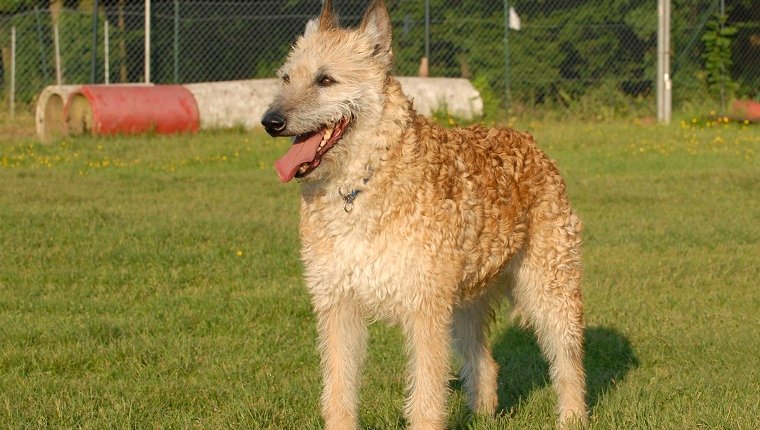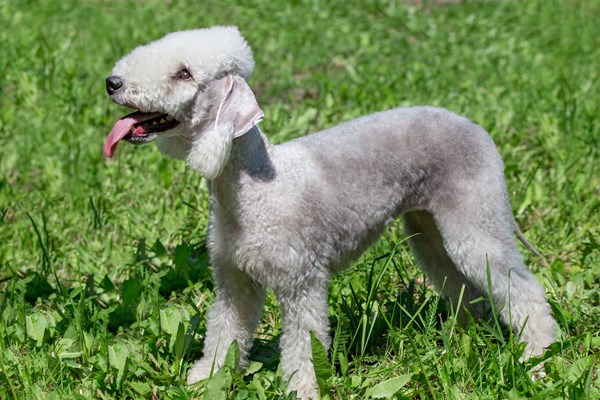Blue Lacy Dog Overview
The Blue Lacy is known as a medium-sized dog with a light, balanced, yet strong frame. Lacy movement correctly implies high speed, strength, and dexterity. It has a short, sleek coat.
Three distinct color variations are permitted. Blues are shades of gray ranging from pale silver to dark charcoal. Reds range in color from pale cream to red.
The tri blends these hues with a blue base and strong red trim accents. On the breast, stomach, and paws, white can occur.
Both red and tricolored Lacys are referred to as Blue Lacys because of their blue-colored gene.
All Blue Lacys’ eyes are a vibrant and striking orange to yellow hue, which adds an element of uniqueness to their appearance.
Lacy in blue Dogs are intelligent, intense, active, and vigilant in general. These canines were developed to be both hunting and herding dogs and exhibit a high level of drive and determination when working with large game and challenging livestock.
Young canines may possess an excessive amount of energy and desire for little children. They are simple to teach and quickly pick up new skills.
Blue Lacy Highlights
- In 2005, Texas recognized the Blue Lacy as the official state dog breed.
- Fred Gipson, the novel’s author, grew up in the county adjacent to where the Lacy family resided and raised their Blue Lacys, which may have inspired him as a writer, however Old Yeller, the novel’s actual dog, was most likely a Black Mouth Cur and not a Blue Lacy.
- Blue Lacys can also have red or tri-colored coats, despite the fact that they all inherit the blue coat gene.
- The American Kennel Club does not recognize the Blue Lacy breed, while several organizations have asked for the breed to be enrolled into the AKC’s Foundation Stock Service, which assists in maintaining official records of the breed in the hope that it would one day be recognized. Nonetheless, complete acknowledgment may take many years or may never happen.
- Blue Lacys are extremely bright and receptive to teaching, but they require an authoritative teacher who can enforce the law without being excessively punished.
- This breed is diligent and performs well when assigned a duty. They are adept in hunting, herding, agility training, watchdog duties, and even search and rescue.
- Suggestions for mental and physical stimulation are required. Blue Lacys require many runs and walks throughout the day to expend their energy. They prefer open areas to run around in tiny apartments.
Blue Lacy Breed Features & Ratings:
Rated base on a 5 Star Scale
ENERGY LEVEL: 5 Star
EXERCISE REQUIREMENTS: 5 Star
PLAYFULNESS: 4 Star
AFFECTION LEVEL: 4 Star
FRIENDLINESS TO DOGS: 2 Star
FRIENDLINESS TO OTHER PETS: 2 Star
FRIENDLINESS TO STRANGERS: 2 Star
WATCHFULNESS: 5 Star
EASE OF TRAINING: 5 Star
GROOMING REQUIREMENTS: 5 Star
HEAT SENSITIVITY: 4 Star
VOCALITY 5 Star
Blue Lacy Characteristics:

- Dog Breed Group: Working Dogs
- Height: 18-23 inches (46-58 cm)
- Weight: 30-50 pounds (13-23 kg)
- Life Span: 14 to 16 years
- Type: Crossbreed
- AREA OF ORIGIN: Texas
- DATE OF ORIGIN: 19th Century
- OTHER NAMES: Lacy Dog, Lacy Game Dog, Texas Blue Lacy, Lacy Hog Dog
- Temperament: Active, Alert, Bold, Devoted, Intelligent, Intense
- Activities: Hunting, Herding, Agility training
- Color: Blue (gray, light silver, charcoal), red (light cream, rust), or tri-colored
- Litter Size: 3 to 5 puppies
- Puppy Prices: Between $400 to $600 USD on average
Blue Lacy Health:
While the Blue Lacy is a generally healthy and sturdy breed, they are occasionally genetically predisposed to a few health problems.
Blue Lacys have been reported to develop hip or elbow dysplasia, hypothyroidism, and dietary allergies on occasion.
They may also suffer skin issues, and while it is uncommon, some may be born with color dilution alopecia, a disorder that results in patches of hair loss or complete hair loss.
Blue Lacy Grooming:
Contrary to their name, the Blue Lacy can come in three color variants.
The term “blues” refers to a range of colors ranging from gray to nearly black. “Reds” can range from a delicate cream hue to a reddish-brown, rust hue.
Tris have a blue base coat with red markings and white along the belly, chin, and paws. Their coat hues tend to draw attention to their yellow or amber eyes.
The Blue Lacy has a short, silky coat. There is little, if any, undercoat present. Blue Lacys lose an average amount, though shedding is more intense during the breeding season.
They do not require much grooming. They should be brushed weekly and washed as needed.
Blue Lacy Exercise:
Even daily walks of several hours would be insufficient for a real working dog of this breed. They have an incredible tolerance for exertion and are always on the go.
They flourish when given opportunities to work hard and are unsuited to a sedentary, indoor lifestyle.
Without the activity they want, they would surely engage in destructive and other unpleasant behaviors.
Indeed, it is fairly uncommon for families to acquire a Blue Lacy only to discover that it is not suited to their lifestyle and must be relocated to a more active environment.
Historically, the Blue Lacy has been a far superior working dog than a companion animal.
Blue Lacy Training:
For an untrained owner, training the Blue Lacy might be a near-impossible undertaking.
While they are extremely knowledgeable and quick to learn, they frequently ignore signs, to the point of completely disregarding persons they do not respect.
Their intelligence can be their undoing at times, as they become bored easily and struggle with monotonous jobs.
Both hunting and herding are instinctive behaviors for the Blue Lacy, and they should be able to do these duties with minimal training from an early age.
It is critical to maintain control of the relationship, as the Blue Lacy values supremacy.
As the owner, you must continually act as the pack leader to guarantee that the Blue Lacy regards you highly and will accept your commands without question.
Blue Lacy Food and Nutrition:
The Blue Lacy should do well on a commercially prepared or home-made dog diet (under veterinary supervision).
This lively, high-energy dog should always have access to fresh, clean water.
Blue Lacy Temperament and Personality:
The Blue Lacy dog breed’s mix of intelligence and great energy can result in well-trained working dogs or destructive forces of nature, depending on their mental and physical stimulation level.
Blue Lacys cannot be confined for an extended time, and when bored, they will find their own entertainment in any way possible, even if it involves gnawing or digging in items they are not meant to.
They will require long daily runs and, most likely, more exercise.
Instruction goes a long way, and Blue Lacys react exceptionally well to strong, positive training, while they are highly sensitive and will not tolerate scolding or punishment.
Blue Lacys require extensive training and socialization to overcome their inherent prey drive and territorial temperament.
Blue Lacys can be wary of strangers and even violent toward other pets and animals without early socialization.
They are, however, extremely gentle and protective of their families, even children, and you would be hard-pressed to find a better watchdog.
Because they were bred to assist in hunting and to tree small wildlife, they tend to bark, and once they get going, it might take a long time to get them to calm down.
They should never be left alone for extended durations. When exercised and educated properly, the Blue Lacy is a superb family pet that is extremely devoted and loving.
They function optimally when they have work that allows them to use their physical and mental energy. When given a proper challenge, Blue Lacys are peaceful, pleasant members of the household.
Blue Lacy Care/Upkeep:
The Blue Lacy’s short, dense coat requires very little maintenance: brushing once or twice weekly, with more regular brushing during seasonal shedding periods.
While Lacys adapt well to most living situations and are excellent family pets with proper socialization, they are energetic, high-energy dogs who are unsuitable for apartment living and inexperienced owners.
They will get bored and destructive if left alone for an extended amount of time, and will respond better to an experienced owner who demonstrates the confidence and leadership that these working dogs seek.
As a result, it is critical for Blue Lacy owners to provide plenty of outdoor time, space to run, and, preferably, a task to complete.
These dogs will want lengthy, brisk daily walks and plenty of backyard romps, but even that may not be sufficient; many of these dogs will require a difficult vocation such as herding or hunting, tracking, agility, or flyball.
Blue Lacys are naturally territorial and will go to great lengths to protect their property and family, but their high prey drive may make them uneasy in households with other pets.
Blue Lacys are normally quite easy to teach due to their intelligence, although they are sensitive to yelling; they will always respond better to firm but kind directions.
Due to its origins as a working dog, most breeders want to place these dogs in ranching and hunting homes, preserving their lineage and allowing the Blue Lacy to do what they do best: work.
Blue Lacy Relationship with Children and Other Pets
Blue Lacys are generally well-behaved around youngsters and are rarely aggressive. They are devoted family dogs who are fiercely protective of their owners.
They do, however, have a high degree of energy and are occasionally known to play rough.
As a result, they may not be appropriate for households with very young children who are prone to being knocked over or injuring themselves during rough play.
Blue Lacys have a strong predation drive, which makes them potentially harmful around small animals and other household pets.
They typically do well if nurtured alongside other animals and recognize them as family. Additionally, they can be tolerant of other dogs if they are socialized from an early age.
Having said that, it may be preferable if there are no other tiny animals or pets in the house, and owners should take care that neighboring pets do not approach the Blue Lacys domain, as their instincts may take over and result in an incident.
Blue Lacy Names
| Rank | Boy Names | Girl Names |
| 01 | Max | Bella |
| 02 | Charlie | Daisy |
| 03 | Cooper | Lucy |
| 04 | Jack | Layla |
| 05 | Rocky | Zoey |
| 06 | Duke | Gracie |
| 07 | Tucker | Chloe |
| 08 | Oliver | Stella |
| 09 | Milo | Pepper |
| 10 | Louie | Abbie |
All About Blue Lacy
Blue Lacys have a lot of energy, and they require many lengthy runs and walks each day to burn it off.
They frequently require a job, whether it is hunting, herding, agility training, or acting as a watchdog, or they will become bored and act out, as many clever and active dog breeds do.
Each day, the Blue Lacy requires both physical and mental stimulus. If you live in an apartment or do not have a specific duty in mind for these dogs, you may want to consider a different breed.
While the Blue Lacy is a gentle family dog, they are not recommended for inexperienced owners or families with small pets or very young children due to their high prey drive and level of intensity.
They require early socialization and capable teaching, as they are extremely sensitive and do not tolerate yelling, harsh reprimands, or punishment well.
Blue Lacys are extremely territorial, somewhat suspicious of strangers, and eager to chase anything that moves.
They make great watchdogs, though extensive socialization training is required to teach them when to be on guard and when to be nice to other pets and people.
The Blue Lacy will work as diligently and ceaselessly as you require, and they are well-suited for farm and hunting labor, as well as agility training and even search and rescue work.
If you’re careful, you’ll end up with a well-trained, intelligent, adaptive friend who will do almost anything for you.
Blue Lacy History:
The Blue Lacy has always enjoyed having a task to complete—as well as plenty of wide-area to romp around in.
While some Blue Lacys have red or tri-colored coats, all of these dogs inherit the blue coloring gene.
They were developed to be energetic, devoted dogs capable of handling livestock ranging from longhorn cattle to hens.
They have been depended upon throughout history as reliable watchdogs and for herding and driving duties.
The Lacy dog was named after Frank, George, Ewin, and Harry Lacy. In 1858, the brothers relocated from Kentucky to Texas, settling in the Hill Country and developing the breed for working free-roaming hogs.
According to historical records, the Lacy is a cross between Greyhounds, scenthounds, and wolves.
The Texas Senate officially recognized the Lacy in 2001, and Governor Rick Perry signed legislation designating the Blue Lacy as the official State Dog Breed of Texas in June 2005.
Considered capable of performing five times a cowboy’s work, the breed was originally utilized for hog hunting, identifying wounded deer, and pursuing game.
As the family-owned ranching industry began to dwindle, partly due to technological advancements such as all-terrain vehicles, the Lacy breed came perilously close to extinction at one point.
However, the species was rediscovered as a hunting companion, which significantly raised the demand for Lacys—they are now the most popular breed employed by trappers in the United States.
For much over a century, the Blue Lacy dog served colonial Americans throughout the Southwestern United States on their ranches.
Indeed, some believe that the presence of these dogs in the Hill Country impacted Fred Gipson, who was raised in nearby Mason County and wrote the novel Old Yeller.
Though most Lacy dogs are still found in that portion of the country (mainly in Texas), the breed is gaining popularity for its hunting ability, and breeding communities are being formed throughout the United States, Canada, and Europe.
Where to Adopt Blue Lacy:
Always check with your local animal shelters and rescue organizations for Blue Lacy dogs in need of a forever home.
The National Lacy Dog Association, the national rescue organization for Blue Lacys, may also give internet information to assist you in finding your new best buddy.
More Dog Breeds and Further Research:
When selecting a dog breed, be careful to conduct your research.
Consult with other Blue Lacy owners, trustworthy breeders, and rescue organizations to gain additional knowledge about this breed and its care.
There are numerous dog breeds, and with a little research, you may be certain that you’ll select the perfect dog for your family.
If you’re interested in learning more about different working breeds, explore the following:
Blue Lacy Fun Facts:
- The Blue Lacy is a cross between the Greyhound, the scent hound, and the coyote.
- They are well-known for their great energy, diligence, and devotion to their families.
- Additionally, they are noted for their fortitude, which comes in handy when dealing with large game or troublesome livestock.
Frequently Asked Questions (FAQs):
In the 1800s, the Blue Lacy was developed in Texas to aid in herding, hunting, and ranch chores. Although these dogs are tough, versatile, and rapid learners, their high intensity and energy level make them unsuitable for apartment living or inexperienced owners.
According to historical records, the Lacy is a cross between Greyhounds, scenthounds, and wolves.
Oval to round in shape and compact in size, with well-arched toes and robust padding. Webbed toes are possible.




